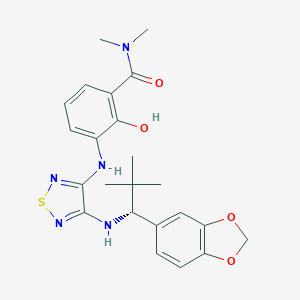

You can:
| Name | CHEMBL522959 |
|---|---|
| Molecular formula | C23H27N5O4S |
| IUPAC name | 3-[[4-[[(1R)-1-(1,3-benzodioxol-5-yl)-2,2-dimethylpropyl]amino]-1,2,5-thiadiazol-3-yl]amino]-2-hydroxy-N,N-dimethylbenzamide |
| Molecular weight | 469.56 |
| Hydrogen bond acceptor | 9 |
| Hydrogen bond donor | 3 |
| XlogP | 5.3 |
| Synonyms | BDBM50247947 SCHEMBL13208144 (R)-3-(4-(1-(benzo[d][1,3]dioxol-5-yl)-2,2-dimethylpropylamino)-1,2,5-thiadiazol-3-ylamino)-2-hydroxy-N,N-dimethylbenzamide |
| Inchi Key | FIBJPCXODZVPBQ-IBGZPJMESA-N |
| Inchi ID | InChI=1S/C23H27N5O4S/c1-23(2,3)19(13-9-10-16-17(11-13)32-12-31-16)25-21-20(26-33-27-21)24-15-8-6-7-14(18(15)29)22(30)28(4)5/h6-11,19,29H,12H2,1-5H3,(H,24,26)(H,25,27)/t19-/m0/s1 |
| PubChem CID | 135937901 |
| ChEMBL | CHEMBL522959 |
| IUPHAR | N/A |
| BindingDB | 50247947 |
| DrugBank | N/A |
Structure |  |
| Lipinski's druglikeness | This ligand has a partition coefficient log P greater than 5. |
You can:
| GLASS ID | Name | UniProt | Gene | Species | Length |
|---|---|---|---|---|---|
| 559755 | C-X-C chemokine receptor type 1 | P25024 | CXCR1 | Homo sapiens (Human) | 350 |
| 559756 | C-X-C chemokine receptor type 2 | P25025 | CXCR2 | Homo sapiens (Human) | 360 |
zhanglab![]() zhanggroup.org | +65-6601-1241 | Computing 1, 13 Computing Drive, Singapore 117417
zhanggroup.org | +65-6601-1241 | Computing 1, 13 Computing Drive, Singapore 117417